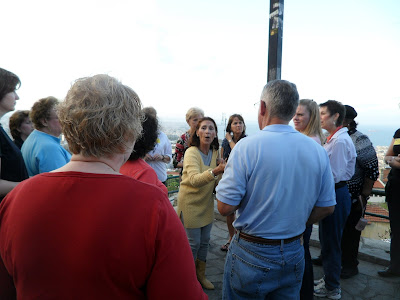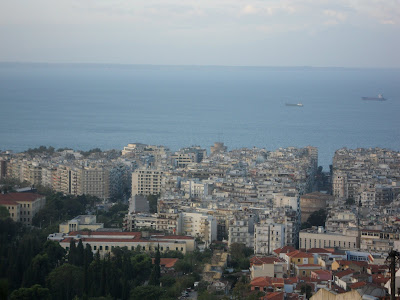

After a much needed night's sleep at the Macedonia Palace which sits on the Thermaikos Gulf, we got on the bus and headed for Philippi.

We did make one quick stop on our way out of Thessaloniki and Andy (our guide) is quickly giving us so much information that this is the first of many times I wish I had brought a small recorder just to capture her!
We have stopped in the Upper City of Thessaloniki to view the Byzantine Walls that date as far back as 315 BC. There are towers still standing at the corners that provide panoramic views of Thessaloniki along with an insight into the Byzantine culture. Originally, the Walls confined the city but today the Walls lie in the center of the city.

From this vantage point we could see all the way to our hotel on the waterfront!

This is a new friend, Angela! She is a lovely young woman who's job has her working in India! Rumor has it that she is a computer genius and invaluable to her company. Of course, how many people immediately thought of the new series, Outsourced, when I mentioned India. She had just seen me trip going up the stairs so I made her climb up there and take her picture with me!


We are finding our seats here as this is where Kay will teach Philippians to us! I had video taped her on my iphone (which turned out pretty amazing - yeah, iphone) and had hoped to have a clip here but I think the file was to big to upload. As always, Kay's teaching was amazing! On a side note, this theatre is used on occasion for summer concerts?! Isn't it incredible that something that old is still utilized today!
 After our teaching, we drove in to Kavala (Neapolis) for lunch. Ancient Neapolis was the port city that Paul entered after leaving Samothrace which is a mountainous island near the coast of Thrace. Ancient Neapolis was colonised by the Athenians in the fifth century BC and remained their ally until it was taken by Philip II in the mid fourth century BC. From then on it served as the port of the nearby city of Philippi and trade brought it prosperity down to the time of the dissolution of the Macedonian state. Today it is a modern port city with it's age old character plain to see. The harbor where we ate is dominated by the Byzantine Fortress. If you look up behind the restaurant you can see the Byzantine wall.
After our teaching, we drove in to Kavala (Neapolis) for lunch. Ancient Neapolis was the port city that Paul entered after leaving Samothrace which is a mountainous island near the coast of Thrace. Ancient Neapolis was colonised by the Athenians in the fifth century BC and remained their ally until it was taken by Philip II in the mid fourth century BC. From then on it served as the port of the nearby city of Philippi and trade brought it prosperity down to the time of the dissolution of the Macedonian state. Today it is a modern port city with it's age old character plain to see. The harbor where we ate is dominated by the Byzantine Fortress. If you look up behind the restaurant you can see the Byzantine wall. Tony and I had a fun lunch with Brigadier General Joe Frazar and his wife Marilyn.
Tony and I had a fun lunch with Brigadier General Joe Frazar and his wife Marilyn. Marilyn insisted on taking this picture and what it made me think of was the rain shower we experienced while Kay was teaching!
Marilyn insisted on taking this picture and what it made me think of was the rain shower we experienced while Kay was teaching! After lunch we went back to Philippi to walk the archaeological site. I am sitting in the acropolis or the upper city.
After lunch we went back to Philippi to walk the archaeological site. I am sitting in the acropolis or the upper city.

This is a structure traditionally identified as Paul's Prison (Acts 16). However, we were told that this is not where a prison would have been located, and it was actually a Roman cistern or crypt transformed into a Christian chapel. There are some frescoes inside.

This is a view of Philippi from the acropolis, with the forum in the foreground and Basilica B in the background.

This is a section of the Via Egnatia. The Via Egnatia was built beginning in 145 B.C. and at its greatest extent connected Byzantium with the Adriatic ports. This route was Rome's primary artery to the east and Philippi was an important outpost along the road. The Egnatian Way made it easier for Rome to move troops throughout the empire and it was the route that Paul traveled on from Neapolis to Philippi, Amphipolis, Apollonia and Thessalonica. Adjacent to the road is the Roman forum, the administrative center of Philippi. (The Via Egnatia can be seen throughout the countryside and in the modern city of Veria.) Its length varied according to the period, but Roman milestones suggest it was 535 Roman miles long (= 493 English miles [790 km.]).

East of the Roman agora (marketplace) are the remains of the Octagon or Basilica of Paul, a cathedral church built c.400 AD over the ruins of an earlier chapel. A mosaic inscription here reads, "Porphyrios, bishop, made the embroidery [mosaic floor] of the basilica of Paul in Christ." The Octagon was destroyed in the early 7th century.
 Beautiful mosaic pavement in the Basilica.
Beautiful mosaic pavement in the Basilica.
On our way back to the bus Tony and I stopped to have our picture made at the bema, or judgment seat. It is hard to see from this angle but it is an elevated outcropping above the agora. It would have been here that Paul and Silas would have been tried.
"But when her masters saw that their hope of profit was gone, they seized Paul and Silas and dragged them into the market place before the authorities," Acts 16:19
 Back at our hotel at the end of Day Two! We had a relaxing view out our window and it was a needed respite to all that we had learned that day.
Back at our hotel at the end of Day Two! We had a relaxing view out our window and it was a needed respite to all that we had learned that day.One day, while Paul, Luke and Silas were on their way to prayer, they were harassed by a slave girl possessed with the “spirit of divination” (pythoness). Apollo, the god of prophecy and the giver of oracles at his shrine in Delphi, inspired this “spirit.” Not wanting an endorsement from the “enemy,” Paul cast the demon out of the girl (Acts 16:16–18; cf. Lk 4:31–37).
The designated place of Paul and Silas's imprisonment is of dubious authenticity, but it remembers the attack on these men and their subsequent flogging and imprisonment. In the course of the night, a violent earthquake shook the prison and the jailer feared that all might have escaped. After learning that none had fled, the Philippian jailer put his faith in Christ and was baptized with his family.


No comments:
Post a Comment